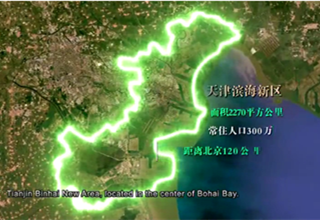Tianjin city: a 615-old jewel of China

Night view of "Tianjin Eye" Ferris Wheel [Photo/xinhua]
Lying on the coast of Bohai Sea, the port city of Tianjin which recently celebrated its 615th birthday, sustains a legacy that's both Chinese and Western, old and new.
Here old western buildings coexist with the intelligent modern Binhai New Area, while local folk arts are performed in exotic bars.
The place where the South Canal, North Canal and the Ziya River converge was historically called San Hui Hai Kou – literally, estuary of the three rivers -- is the birthplace of Tianjin.
Emperor Yongle of the Ming Dynasty (1368-1644)-- considering the military importance of Tianjin -- issued an imperial edict on December 23, 1404, to build a fort there. He named the area Tianjin, meaning the place where the emperor crosses the river.Tianjin thus became the only city in China whose establishment can accurately be found in historical documents.
Tianjin is also called "Tianjin Wei", or Fort Tianjin. The word wei means a fort. Wei was the commanding administration of the Wei-suo System, a military system of garrison units set up in strategic locations along the frontiers during the Ming Dynasty, equivalent to the contemporary military garrison headquarters.
Tianjin prosperous with development of canal
Adjacent to the sea and rivers, Tianjin enjoys distinct geographical advantages. After the opening of the Beijing-Hangzhou Grand Canal in the Sui Dynasty (581-618), Tianjin became an important transport node between the canal and the sea, becoming a natural hub for waterway transportation.
After the middle period of the Tang Dynasty (618-907), Tianjin became a hub for the transportation of grain and silk from the south to the north.
Tianjin has played a significant role in the economic exchanges and development between the North and South of China. In the late Qing Dynasty (1644-1911), with foreign trade developing rapidly, Tianjin became the largest commodity distribution center in northern China. As a result Haihe, with its radiating tributaries connecting up to eight provinces, grew in importance.
Tianjin as a mirror of China's modern history
Tianjin has experienced dramatic ups and downs, involved in historical events such as the Yihetuan Movement (also known as Boxer Rebellion), Self-Strengthening Movement (1861-1895), the Eight-Nation Alliance, China's War of Resistance Against Japanese Aggression (1937-45) and foundation of the People's Republic of China -- all symbolic of China's turbulent history and relationship with foreign influences.
On June 10, 1890, the Eight-Nation Alliance -- a multi-national foreign military coalition of the German Empire, Japan, Russia, Britain, France, the US, Italy and Austria-Hungary--departed Tianjin by train during the the Yihetuan Movement to invade the capital, Beijing.
The Boxer fighters, with their self-avowed mission to defend the Qing Dynasty against the foreign invaders, tried to stop the invasion by wrecking the railway.
The foreign alliance had no choice but return to Tianjin where they defeated the Boxer fighters.
The Eight-Power Allied Forces subsequently conquered Beijing, forcing the Qing government to sign the humiliating Treaty of 1901.
The Self-Strengthening Movement entered China's history as a result of the government's decision to save the country through learning from the West.

Copyright © Tianjin Municipal Government. All rights reserved. Presented by China Daily



